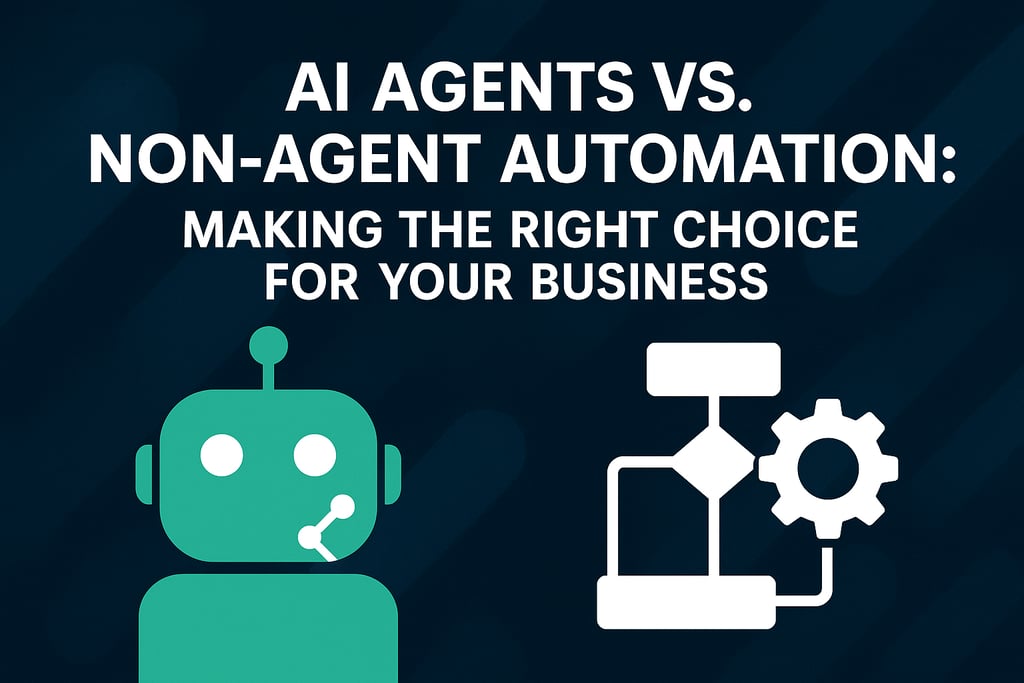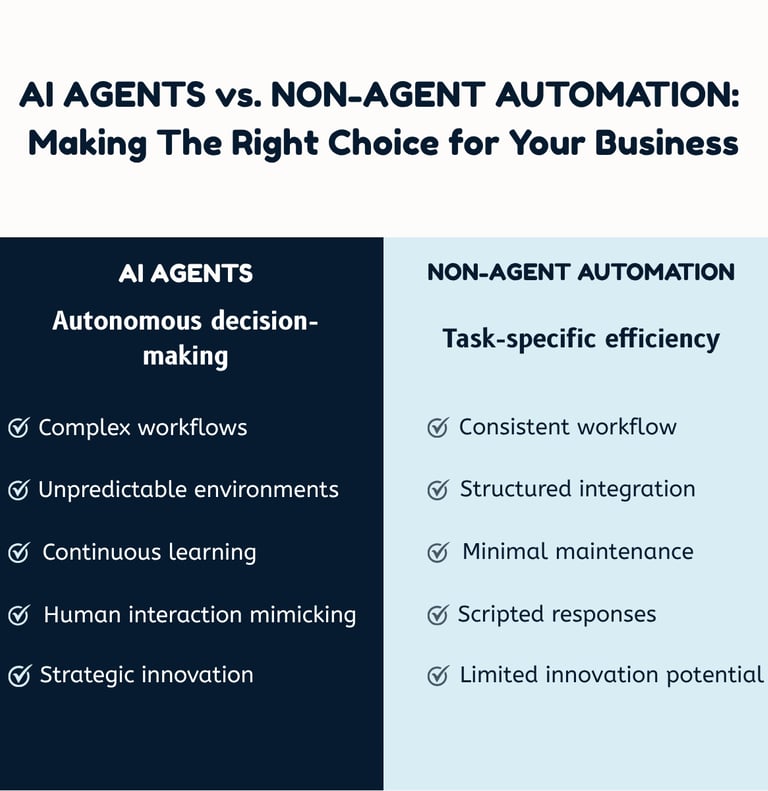AI Agents vs. Non-Agent Automation: Choosing the Right Solution for Your Business
5/6/20254 min read


In today's rapidly evolving digital landscape, artificial intelligence offers transformative potential for businesses of all sizes. However, navigating the complex ecosystem of AI solutions presents a critical strategic decision. You can evaluate your business needs to determine whether to implement AI agents or non-agent automation. This choice significantly impacts implementation costs, timelines, and ultimate business value. Let's explore the key differences and decision factors to help you make an informed decision that best aligns with your business needs.
Understanding the Fundamental Differences
AI Agents: Autonomous Decision-Makers
AI agents are a more sophisticated implementation of artificial intelligence designed with greater autonomy and adaptability. These systems can operate independently within defined parameters, making decisions and adjusting their approach based on changing conditions and feedback. Their potential to transform your business is immense, offering a future where complex tasks are handled with ease and adaptability.
An AI agent is a system that can perceive its environment, make decisions, and take actions to achieve specific goals. It is characterized by its ability to reason, learn from experiences, and operate with varying degrees of autonomy. This autonomy allows it to handle complex tasks involving multiple steps, changing conditions, and unpredictable elements.
Non-Agent Automation: Task-Specific Efficiency
Non-agent automation, on the other hand, refers to AI systems designed to perform specific, well-defined tasks with high efficiency and reliability. These solutions follow predetermined rules and workflows, providing a reliable and consistent approach to task execution.
Non-agent automation typically involves rule-based systems or machine learning models trained for specific use cases. These systems excel at performing repetitive, structured tasks with consistency and precision. While they lack the adaptability of agents, they offer predictability, cost-effectiveness, and more straightforward implementation.
When to Choose AI Agents
Consider implementing agent-based AI systems when your business needs align with these scenarios:
Complex, Multi-Step Workflows: When processes require coordination across different systems, data sources, or departments.
Unpredictable Environments: These are situations where conditions frequently change and the system needs to adapt in real time without human intervention.
Continuous Learning Requirements: When the solution's value increases significantly through ongoing learning and improvement over time.
Enhanced User Experience: Human-like interaction would substantially improve user engagement and satisfaction.
Strategic Innovation Focus: For organizations prioritizing cutting-edge capabilities and competitive differentiation through technology.
Real-World Examples of Agent Applications
Intelligent virtual assistants that can schedule meetings, book travel, and respond to queries by coordinating across multiple systems
Autonomous customer service agents that handle complex inquiries
Inventory management systems that proactively adjust ordering based on multiple variables
Dynamic pricing engines that respond to market conditions in real-time
When to Choose Non-Agent Automation
Structured, Repetitive Tasks: For well-defined processes with clear inputs and outputs.
Speed and Precision Are Critical: When consistent execution with minimal variation is more important than adaptability.
Budget Constraints Exist: When seeking cost-effective implementation with lower initial investment and maintenance costs.
Integration With Legacy Systems: When minimal disruption to existing infrastructure is required.
Compliance and Predictability: In highly regulated industries, predictable outcomes are non-negotiable.
Practical Examples of Non-Agent Applications
Document processing systems that extract and categorize information from standardized forms
Quality control systems that identify defects in manufacturing
Automated data entry and validation processes
Standard report generation and distribution workflows


Key Decision Factors: A Comprehensive Evaluation Framework
To make an informed choice between agent and non-agent solutions, evaluate your specific situation against these critical factors:
Technical Complexity
Implementation difficulty
Integration requirements
Maintenance considerations
Risk Profile
Tolerance for variability in outputs
Consequences of system errors
Regulatory compliance needs
Timeline Considerations
Urgency of implementation
Development cycle constraints
Phased approach potential
Resource Availability
Budget parameters
Technical expertise access
Ongoing support capabilities
Strategic Alignment
Long-term technology roadmap
Competitive positioning
Core business priorities
The Hybrid Approach: Best of Both Worlds
Many successful AI implementations leverage agent and non-agent components in a complementary architecture. This hybrid approach allows organizations to apply the right solution to each aspect of their business challenges.
For example, a customer service operation might use non-agent automation for routine inquiries and transaction processing while deploying agent-based solutions for complex problem-solving and personalized recommendations.
Implementation Considerations
Regardless of which approach you select, successful AI implementation requires:
Clear Success Metrics: Define specific, measurable outcomes that represent success.
Data Strategy: Ensure you can access the quality data needed for training and operation.
Change Management: Prepare your organization for new workflows and capabilities.
Governance Framework: Establish oversight mechanisms for ethical and responsible AI use.
Regardless of the AI approach you choose, continuous evaluation is crucial. This ongoing process allows you to measure performance and identify areas for improvement, ensuring that your AI solutions continue to deliver meaningful business impact.
Making Your Decision
The choice between AI agents and non-agent automation isn't simply about technological sophistication—it's about finding the right match for your specific business context, challenges, and objectives.
For many organizations, the journey begins with targeted non-agent solutions addressing well-defined problems, gradually expanding toward more sophisticated agent-based applications as experience and capabilities mature.
By thoroughly evaluating your requirements against the frameworks outlined above, you can make strategic AI choices that deliver meaningful business impact while managing implementation complexity and risk.
For personalized guidance on selecting and implementing the optimal AI solution for your business needs, consider consulting with specialists who can provide expert assessment and recommendations tailored to your unique situation.
Are you ready to navigate the AI implementation journey with confidence? Our consultative approach meets you exactly where you are—whether you're taking your first steps into AI or looking to optimize existing systems. Contact our AI consulting team today to discuss how we can help you select and implement the right AI solutions for your business.
AI Suite
Transform your business with AI-powered no-code/low-code solutions
Consulting
AI Solutions trends
info@aisuite.io
© 2025. AISuite All rights reserved.
